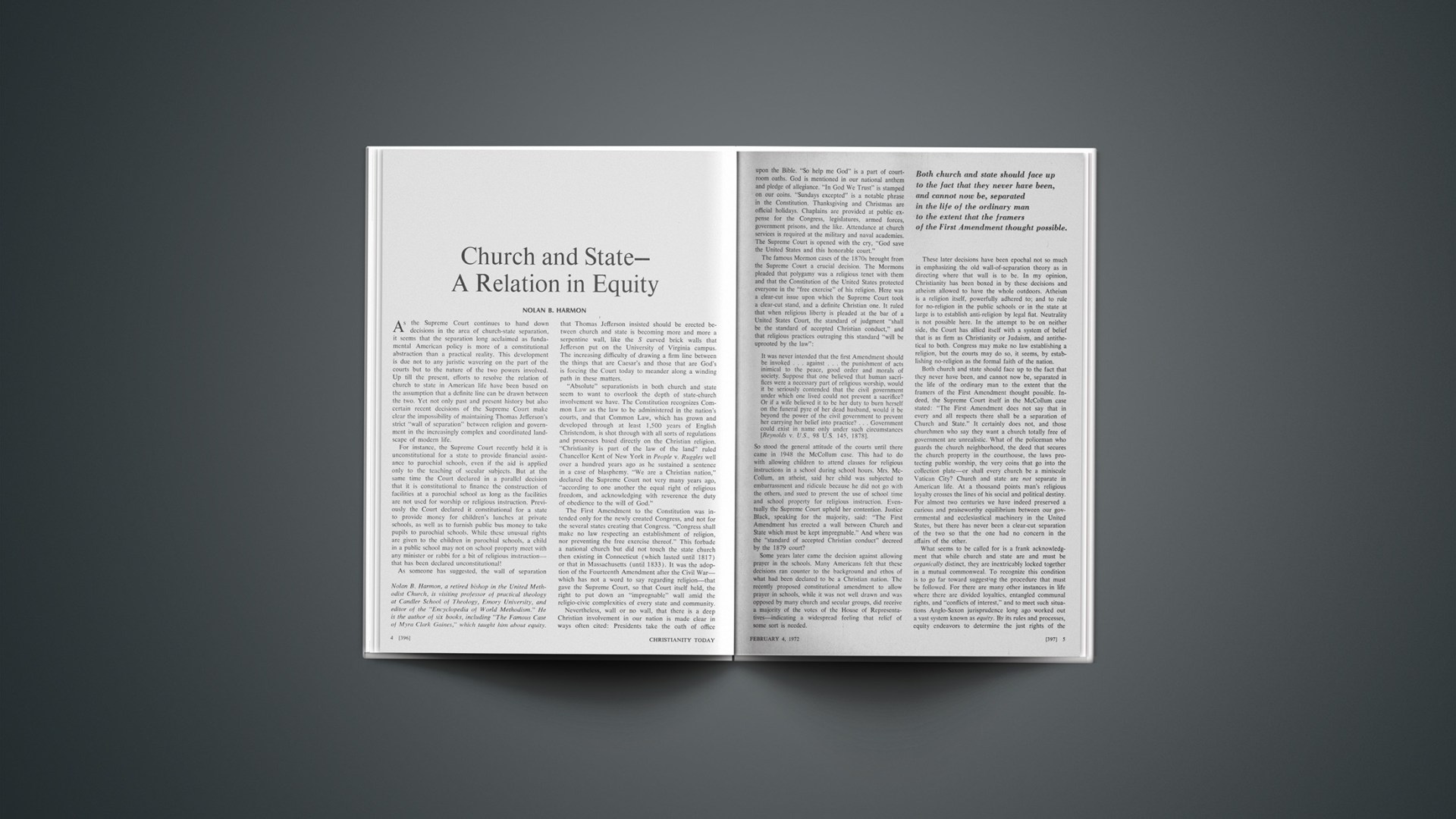As the Supreme Court continues to hand down decisions in the area of church-state separation, it seems that the separation long acclaimed as fundamental American policy is more of a constitutional abstraction than a practical reality. This development is due not to any juristic wavering on the part of the courts but to the nature of the two powers involved. Up till the present, efforts to resolve the relation of church to state in American life have been based on the assumption that a definite line can be drawn between the two. Yet not only past and present history but also certain recent decisions of the Supreme Court make clear the impossibility of maintaining Thomas Jefferson’s strict “wall of separation” between religion and government in the increasingly complex and coordinated landscape of modern life.
For instance, the Supreme Court recently held it is unconstitutional for a state to provide financial assistance to parochial schools, even if the aid is applied only to the teaching of secular subjects. But at the same time the Court declared in a parallel decision that it is constitutional to finance the construction of facilities at a parochial school as long as the facilities are not used for worship or religious instruction. Previously the Court declared it constitutional for a state to provide money for children’s lunches at private schools, as well as to furnish public bus money to take pupils to parochial schools. While these unusual rights are given to the children in parochial schools, a child in a public school may not on school property meet with any minister or rabbi for a bit of religious instruction—that has been declared unconstitutional!
As someone has suggested, the wall of separation that Thomas Jefferson insisted should be erected between church and state is becoming more and more a serpentine wall, like the S curved brick walls that Jefferson put on the University of Virginia campus. The increasing difficulty of drawing a firm line between the things that are Caesar’s and those that are God’s is forcing the Court today to meander along a winding path in these matters.
“Absolute” separationists in both church and state seem to want to overlook the depth of state-church involvement we have. The Constitution recognizes Common Law as the law to be administered in the nation’s courts, and that Common Law, which has grown and developed through at least 1,500 years of English Christendom, is shot through with all sorts of regulations and processes based directly on the Christian religion. “Christianity is part of the law of the land” ruled Chancellor Kent of New York in People v. Ruggles well over a hundred years ago as he sustained a sentence in a case of blasphemy. “We are a Christian nation,” declared the Supreme Court not very many years ago, “according to one another the equal right of religious freedom, and acknowledging with reverence the duty of obedience to the will of God.”
The First Amendment to the Constitution was intended only for the newly created Congress, and not for the several states creating that Congress. “Congress shall make no law respecting an establishment of religion, nor preventing the free exercise thereof.” This forbade a national church but did not touch the state church then existing in Connecticut (which lasted until 1817) or that in Massachusetts (until 1833). It was the adoption of the Fourteenth Amendment after the Civil War—which has not a word to say regarding religion—that gave the Supreme Court, so that Court itself held, the right to put down an “impregnable” wall amid the religio-civic complexities of every state and community.
Nevertheless, wall or no wall, that there is a deep Christian involvement in our nation is made clear in ways often cited: Presidents take the oath of office upon the Bible. “So help me God” is a part of courtroom oaths. God is mentioned in our national anthem and pledge of allegiance. “In God We Trust” is stamped on our coins. “Sundays excepted” is a notable phrase in the Constitution. Thanksgiving and Christmas are official holidays. Chaplains are provided at public expense for the Congress, legislatures, armed forces, government prisons, and the like. Attendance at church services is required at the military and naval academies. The Supreme Court is opened with the cry, “God save the United States and this honorable court.”
The famous Mormon cases of the 1870s brought from the Supreme Court a crucial decision. The Mormons pleaded that polygamy was a religious tenet with them and that the Constitution of the United States protected everyone in the “free exercise” of his religion. Here was a clear-cut issue upon which the Supreme Court took a clear-cut stand, and a definite Christian one. It ruled that when religious liberty is pleaded at the bar of a United States Court, the standard of judgment “shall be the standard of accepted Christian conduct,” and that religious practices outraging this standard “will be uprooted by the law”:
It was never intended that the first Amendment should be invoked … against … the punishment of acts inimical to the peace, good order and morals of society. Suppose that one believed that human sacrifices were a necessary part of religious worship, would it be seriously contended that the civil government under which one lived could not prevent a sacrifice? Or if a wife believed it to be her duty to burn herself on the funeral pyre of her dead husband, would it be beyond the power of the civil government to prevent her carrying her belief into practice?… Government could exist in name only under such circumstances [Reynolds v. U.S., 98 U.S. 145, 1878].
So stood the general attitude of the courts until there came in 1948 the McCollum case. This had to do with allowing children to attend classes for religious instructions in a school during school hours. Mrs. McCollum, an atheist, said her child was subjected to embarrassment and ridicule because he did not go with the others, and sued to prevent the use of school time and school property for religious instruction. Eventually the Supreme Court upheld her contention. Justice Black, speaking for the majority, said: “The First Amendment has erected a wall between Church and State which must be kept impregnable.” And where was the “standard of accepted Christian conduct” decreed by the 1879 court?
Some years later came the decision against allowing prayer in the schools. Many Americans felt that these decisions ran counter to the background and ethos of what had been declared to be a Christian nation. The recently proposed constitutional amendment to allow prayer in schools, while it was not well drawn and was opposed by many church and secular groups, did receive a majority of the votes of the House of Representatives—indicating a widespread feeling that relief of some sort is needed.
These later decisions have been epochal not so much in emphasizing the old wall-of-separation theory as in directing where that wall is to be. In my opinion, Christianity has been boxed in by these decisions and atheism allowed to have the whole outdoors. Atheism is a religion itself, powerfully adhered to; and to rule for no-religion in the public schools or in the state at large is to establish anti-religion by legal fiat. Neutrality is not possible here. In the attempt to be on neither side, the Court has allied itself with a system of belief that is as firm as Christianity or Judaism, and antithetical to both. Congress may make no law establishing a religion, but the courts may do so, it seems, by establishing no-religion as the formal faith of the nation.
Both church and state should face up to the fact that they never have been, and cannot now be, separated in the life of the ordinary man to the extent that the framers of the First Amendment thought possible. Indeed, the Supreme Court itself in the McCollum case stated: “The First Amendment does not say that in every and all respects there shall be a separation of Church and State.” It certainly does not, and those churchmen who say they want a church totally free of government are unrealistic. What of the policeman who guards the church neighborhood, the deed that secures the church property in the courthouse, the laws protecting public worship, the very coins that go into the collection plate—or shall every church be a miniscule Vatican City? Church and state are not separate in American life. At a thousand points man’s religious loyalty crosses the lines of his social and political destiny. For almost two centuries we have indeed preserved a curious and praiseworthy equilibrium between our governmental and ecclesiastical machinery in the United States, but there has never been a clear-cut separation of the two so that the one had no concern in the affairs of the other.
What seems to be called for is a frank acknowledgment that while church and state are and must be organically distinct, they are inextricably locked together in a mutual commonweal. To recognize this condition is to go far toward suggesting the procedure that must be followed. For there are many other instances in life where there are divided loyalties, entangled communal rights, and “conflicts of interest,” and to meet such situations Anglo-Saxon jurisprudence long ago worked out a vast system known as equity. By its rules and processes, equity endeavors to determine the just rights of the parties involved in each case. It is not possible in this brief article to explain fully how “proceedings in equity” differ from “proceedings in law,” but broadly speaking it may be said that courts of equity attempt to remedy situations where strict application of the letter of the law would work unfairly. There is sometimes a harshness about the law when it is rigidly applied that our English forebears saw long ago could make for injustice rather than justice. So eventually there arose chancery courts, or courts of equity, with the judge becoming “chancellor” and determining what is fair to both parties.
As an illustration of entangled rights, think of the equity a city has in a public franchise, such as a bus line, water works, or airport. These concerns, though privately owned, are “public” utilities. Their operation is of vital concern to the city itself. Just what the equity is in each instance is difficult to determine. When the question is before a chancellor, every aspect of the particular case must be considered.
So it should be in working toward an equitable adjustment between any church or religious group and the American state. The exact amount of interest a nation has in its churches, or in an individual church, is an indeterminate matter, just as is the “interest” a church has in the wellbeing of its overarching state. The whole relationship is one to be debated in specific application, but not to be denied in its larger implications. The church has an equity in the state and the state has an equity in the church, or to put it in common parlance, each has a stake in the other.
This equitable viewpoint, while it will determine nothing with finality and will frankly open the way for more “serpentining,” will at the same time give a better background for the cooperation that must prevail. Equity would seem to allow those churches that have put the most into the life of the nation to feel they rightly have a greater share in the nation than others. Christianity certainly has a far greater equity in the United States than has atheism, for instance.
And frankly, unless we can get our courts to rule in equity, I do not see how we can keep the wall of separation from constricting the religious forces of the land more and more. Suppose a Mrs. McCollum sues to get “In God We Trust” off our coins, or to do away with all chaplains in Congress, the legislatures, and the armed forces on the ground that she is taxed to pay for religion in government? How could this move be blocked if the hard, exact law the Court uttered in the McCollum case is to be applied “absolutely” again? But if we are allowed to plead in equity under the compass of the Christian ethos as that has always influenced this nation, I can see the justices—who have supreme power “both in Law and Equity,” as the Constitution says—affirming as did their predecessors: “We are a Christian nation,” and “the standards of accepted Christian conduct must be upheld.”
How, it may be asked, may small minorities and individual rights be protected under such a system? Equity is a vigilant champion at precisely that point. “He that would have equity must do equity” is a fundamental maxim that every chancellor insists upon. In other words, if you come to plead your cause in a court of equity, your own hands must be clean. Every majority must plead in fairness in order to ask for fairness.
But the majority has its rights. In deciding that when the standards of religious liberty were appealed to, these must be the standards of “accepted Christian conduct,” the Supreme Court did no violence to Mormon elders in Utah comparable to what it would have done had it ruled against generations of men and women whose Christian ethics would never permit them to accept polygamy, and who had, moreover, spent their lives carving this nation out of a wilderness.
What future decisions equity may call for in the church-state imbroglio, as ever-increasing complexities arise, cannot be known. I would like to feel, however, that the august justices will act as chancellors and decide future cases in a spirit of balanced justice rather than legal rigidity. If this means more serpentining, so be it.
Nolan B. Harmon, a retired bishop in the United Methodist Church, is visiting professor of practical theology at Candler School of Theology, Emory University, and editor of the “Encyclopedia of World Methodism.” He is the author of six books, including “The Famous Case of Myra Clark Gaines,” which taught him about equity.










